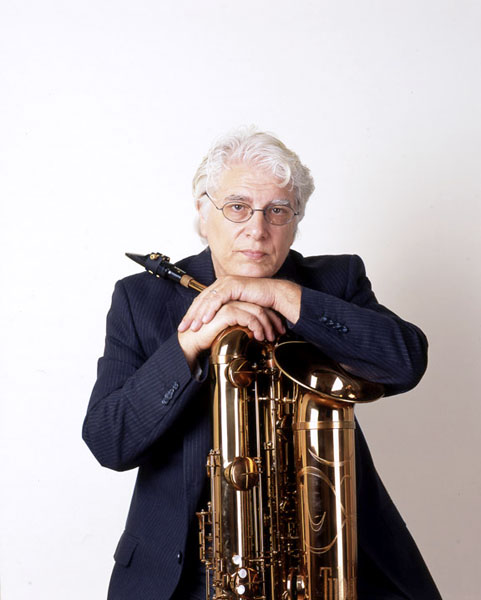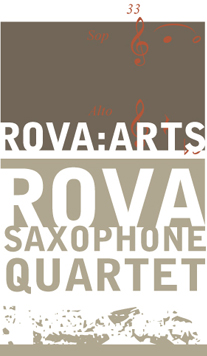+ 1, Guest Contributor, Vinny Golia, February 2015 Vinny Golia
My History Concerning Large Ensembles and Improvisation James Bond and Olatunji - unlikely partners? No. Both were childhood influences who later determined one of my courses of action concerning large ensembles and improvisation. As a kid, when stereo sets were becoming readily available, I went to the surplus store and bought speakers, wires, and clips, and put as many extra speakers as I could mount around the house, so that I could experience the drive and intensity of African drumming by Olatunji, especially his album Drums of Passion, which is what drums were to me then and still are today. Olatunji was one of the first Nigerians to bring the art of African drumming to the United States. The glorious sounds and sheer force of those drums! I can still hear those rhythms and tones now, years and years, decades later. [Read more] Later, in my life working at CalArts, the sound of the African drum is CalArts’ heartbeat, its identity that is imprinted on its hallways; and my office, so near the African drum room brings me to my childhood everyday, and I rejoice in the music in which I am daily immersed. Back to my childhood: alongside Olatunji, there were John Barry’s splendid orchestrations for the James Bond movie From Russia with Love. John Barry studied with a wide array of artists/composers - Dr. Francis Jackson of York Minster and William "Bill" Russo, an arranger for Stan Kenton and his Orchestra. It was mind boggling to me how the two musics encompassed many of the same intensities, colors and rhythms, but in totally reversed situations. Here were color, rhythm, shape and form in their manifest destiny. The influence of these two master musicians and composers resonated through my formative years as a novice performer/composer.
OODA Loops The OODA loops consist of Observation, Orientation, Decision and Action. Boyd emphasized that "the loop" is actually a set of interacting loops that are to be kept in continuous operation.In notes from his talk “Organic Design for Command and Control”[1] (http://www.dni.net/boyd/pdf/c&c.pdf) Boyd stated, “The second O, orientation – as the repository of our genetic heritage, cultural tradition, and previous experiences – is the most important part of the OODA loop since it shapes the way we observe, the way we decide, the way we act” OODA Loop Wikipedia, the free encyclopedia http://en.wikipedia.org/wiki/OODA_Loop “Observation” was the first step, and by listening, I was captured in the world of sound that would become my home in later life. Regarding “Orientation,” being born to Italian-Americans, I was naturally attuned to the full bel canto style of playing with a large sound and a strong melodic sense. Without realizing it, these things carried over into my improvisations when I started to play music. I gravitated to musicians who did the same, people such as John Carter, Bobby Bradford, John Coltrane, Eric Dolphy, Anthony Braxton, Chick Corea, etc. Later in life I made the “Decision” to work in the field of sound, leaving the visual world I had been in. I returned later for a short time, using computer assisted developments and technology not available during the late 60’s and early 70’s. In terms of “Action,” one of my biggest was moving to the West Coast and becoming more involved in music, specifically, composition and improvisation.
Improvisation As in Heisenberg's Uncertainty Principle and the 2nd Law of Thermodynamics, most important to understanding free improvisation (or any improvisation) is that as a system breaks down naturally, another system is building up. Jumping ahead about 20-25 years or so (to be less than precise,) I wanted to have a large ensemble to perform some of the music I wrote, a more integrated meshing of Chamber Music and Jazz, utilizing improvisation in multiple forms. I started listening, and I gravitated toward deeper observation of the existing groups and musicians like the London Jazz Composers Orchestra of Barry Guy, The JCOA, the ICP, The Globe Unity Orchestra, The Berlin Jazz Orchestra, George Russell, Mingus (of course,) and even Stan Kenton - all fantastic large ensembles. Later, a self-determined study of Western classical music combined with music from other cultures (Indian, Tibetan and Indonesian mostly) led me to fuse Eastern and Western forms. The melding of the rhythm, shape, form, and color concepts led me to forgo functional harmony for coloristic or more spectral forms of harmony. All the music I was most involved in while learning was based on rhythm and melody only. I looked for theoretical parallels in the visual art field to map to music. I believe this helped me to orient the music towards a melding of compositional forms. Stage one and two of the loops, “Observation” and “Orientation” had been broached once again. The next two steps, “Decision” and “Action,” were the creation of the music and its implementation. Then a new set of problems occurred, mainly the band! What do we do with all these people, what do they play, why should they stop, who solos and why, how do we transition from one piece to another, conductor or not? The ensemble’s biggest problem eventually was how do we use improvisation with any number and set of people to get the blending of composition and improvisation, which brought me to think about how we use composition and what we are thinking about when we compose. It starts with this idea of total music at the beginning, meaning hearing the composition all the way through as you write. There is no trusting in the Muse that a person will give us the perfect solo. In Jazz the idea of improvising on harmonic structures is still being examined by many Jazz artists under the sway of Bird and Dizzy. So do we just use Jazz musicians or more rounded interpreters? Today the working music group has been abolished into the realities of musical projects, but there is a saving grace - institutional learning - where one can create an army of musicians familiar with your concepts and creations, forging a camaraderie that will be present in an ensemble of large size. The students later will also choose people from such an ensemble for their own projects. Musicians gravitate towards each other to get their own compositions played or write for a specific personage or instrumental ensemble. This gathering of young virtuosi makes presenting one’s music easier, and continues after leaving school. It’s very simple if we know who we write for and we know how to write, thereby giving the piece its color, shape, rhythm, breath, form and life. There is no magic to this, the great orchestras in the world, improvised or not, sound great because the people are hand picked to play the compositions, or the players write for each other. We have to look no further than Ellington, Evans, Mingus, Russell, etc., as examples of this. In my case, since I am the composer, I pick the musicians to play in the ensemble based on who I know at the time and how they function.
Building Blocks Rhythm can be anything, it can be a reggae groove or a great swing feel. However, to me, more and more it's the space between what we play and what we do not play. It's the way we sculpt our tones with silence; how we come off a note... and of course all this rhetoric is true for composing also. Rhythm is our music, we exist for it. I remember the first time I heard Eddie Palmieri and his music (and quite by accident too, when I was living in NYC,) it was like someone ripping off your skull and pouring molten hot lava where your brain should be – a totally amazing sound sculpted by Latin rhythm. Rhythm can also be the way you walk, how you identify your swing, inside and out. It makes you, you. It's really that simple. Attention to how you are doing things is rhythm. Are you sloppy, sullen, depressed? Then your rhythm is way off. Breathing is our rhythm, even the planet breathes - look at the pictures of our earth in space and see it releasing oxygen and carbon dioxide, it is alive and it swings! Then there’s the shape of things, the shape of things to come, as Ornette pronounced. The wondrous densities of our tone, the orchestration of light into what we hear. There’s a true beauty that exists in the spectral continuum and before us in how we shape things. Here it becomes more and more what we do not play. Once more, our silence shapes the tone, our breathing, raspy and crude or refined and sleek like a runner moving to his/her own time, the looseness in the stride and pure ease of how the sound comes out. In silence, we find another fantastic attribute - space, like the hanging chords of Paul Bley or Ran Blake’s blocks of sound, or tones that snake into existence from Morton Feldman or Bhob Rainey. Color, I love color. When I think of it I hear Stravinsky’s instrumental pairings and the clusters of spectral warmth that bring us a Turner landscape. Shaped by our intentions, color is not just what we see, it is how we feel. Definition of color refines the happy joy of ecstasy and also depression or bitterness, the heavy weights we carry. These emotions become the palette, our tools, our weapons, to fight injustices real or imagined. It’s what we have and who we are – color is a long digression into the very soul of our existence here on the planet or planets. Form is what we do with all this. It has to be used as an expressive tool. Form can be the moving gelatinous amoeba-like shape that devours all in its path. I sometimes think of the large ensemble in this way, using everything it surveys to get to the next place. A form must be functional - Bill Russo is functional because he gives us tools to do things with our sounds. John Boyd is functional because he gives us a form in which to think and create - it can be used to fight, or it can be put in front of us to solve the problem. He gives us a tool and we create a form with which to function. What about the Large Ensemble improvisation, you ask? Well, I was never a huge fan of conduction or sound painting for the simple reason that many areas could not be repeated with precision. A way had to be found to be spontaneous with the writing, the solos and the improvisations. (I’m still working on that..but the following might help explain it)…part two??? Vinny GoliaValencia, CA December, 2014 |

